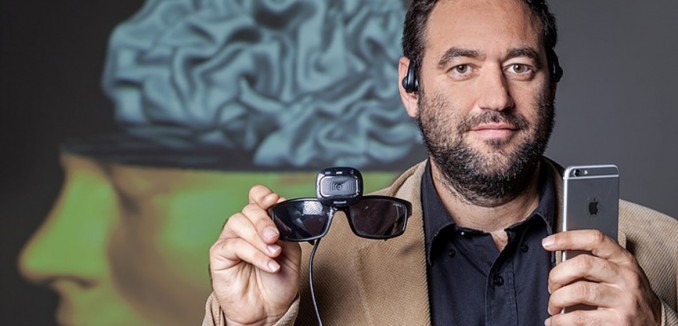In Prof. Amir Amedi’s world-renowned Laboratory for Brain and Multisensory Research at the Hebrew University of Jerusalem, people with vision impairment can “see” their environment with the aid of sensory substitution devices (SSDs) that provide visual information from sound and touch.
Now, two of the lab’s groundbreaking inventions are being readied for the mass market.
EyeCane, a flashlight-like orientation device, emits infrared rays to translate distance into auditory and tactile cues, enabling the user to sense objects within an adjustable range of up to five meters (16 feet). After brief training, EyeCane users can estimate distances, avoid obstacles, and successfully navigate in simple environments.
EyeMusic is an app and mini-camera system that conveys colors, shapes, and location of objects by converting images into “soundscapes” for the brain to interpret visually. Blind individuals can be trained to recognize the letters of the alphabet, “see” pictures of animals, and even find an object or person in a complex visual landscape. A version of the app is available free on the Apple App Store and Google Play.
Commercializing and eventually combining EyeCane and EyeMusic could give unprecedented self-navigation capabilities to blind people, said Daphna Rosenbaum, CEO of RenewSenses, a pre-startup based on Amedi’s research in the medical neurobiology department of the university’s Institute for Medical Research Israel-Canada.
“The white cane is from 1921,” Rosenbaum told ISRAEL21c. “The 21st century high-tech world hasn’t effectively answered the mobility needs of blind people.”
Amir and his team have exhibited the EyeCane prototype at global conferences and exhibitions, and testers in Israel have given enthusiastic testimonials, she says.
“What we offer is independence in understanding and interpreting one’s surroundings using the natural brain processing of interpreting the landscape and objects,” said Rosenbaum. “No machine is as sophisticated as the brain and our solution is based on its elasticity and sensory substitution abilities.”
With the encouragement of the university, RenewSenses entered Brainnovations, a four-month-long accelerator program, in May in order to figure out a business model. The initial version of EyeCane could be available within three or four months of raising production funds.
“The Brainnovations accelerator helps us understand the medical ecosystem, including reimbursement and regulation, and governmental programs like the Innovation Authority [of the Ministry of Economy and Industry],” she said. “It also gives us access to mentors and impact investors, philanthropies, angel investors and VCs as we finalize our business plan.”
EyeCane and EyeMusic are based on different scientific insights than are potentially similar technologies under development elsewhere, Rosenbaum explained. Using infrared rather than ultrasonic rays gives EyeCane has superior accuracy, and it is expected to be more affordable than competitive devices. EyeMusic is the only system of its kind that can effectively convey color and brightness information.
RenewSenses currently has a fulltime R&D manager and Rosenbaum hopes to add a production manager and sales/marketing manager when it gets funded.
All of the current eight Brainnovations startups will present on September 18 at Google Tel Aviv, where the accelerator is housed.
The other seven are BioEye (developing an ADHD diagnostic device using the front camera of mobile phones), Pauzzitive Life (developing a mobile application for treating lifestyle addictions), TailorMed (using machine learning to improve quality and speed of medical image diagnostics), InnoSphere (developing a brain-stimulating device to treat ADHD), MyDopa (using machine learning to adjust the medication dosage of Parkinson patients), Sentidio (developing software to improve the social skills of autistic children) and Re:Mind (developing an at-home diagnostic helmet to detect an early-stage stroke).
(via Israel21c)
[Photo: Eyal Toueg / Israel21c ]




